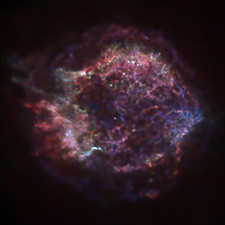December 21, 1999
CXC PR: 99-12
A team of astronomers led by Dr. John Hughes of Rutgers University in Piscataway, NJ has used observations from NASA's orbital Chandra X-ray Observatory to make an important new discovery that sheds light on how silicon, iron, and other elements were produced in supernova explosions. An X-ray image of Cassiopeia A (Cas A), the remnant of an exploded star, reveals gaseous clumps of silicon, sulfur, and iron expelled from deep in the interior of the star.
The findings appear online in the Astrophysical Journal Letters at
http://www.journals.uchicago.edu/
and are slated for print publication on Jan. 10, 2000. Authors of the paper, "Nucleosynthesis and Mixing in Cassiopeia A", are Hughes, Rutgers graduate student Cara Rakowski, Dr. David Burrows of the Pennsylvania State University, University Park, PA and Dr. Patrick Slane of the Harvard-Smithsonian Center for Astrophysics, Cambridge, MA.
According to Hughes, one of the most profound accomplishments of twentieth century astronomy is the realization that nearly all of the elements other than hydrogen and helium were created in the interiors of stars. "During their lives, stars are factories that take the simplest element, hydrogen, and convert it into heavier ones," he said. "After consuming all the hydrogen in their cores, stars begin to evolve rapidly, until they finally run out of fuel and begin to collapse. In stars ten times or so more massive than our Sun, the central parts of the collapsing star may form a neutron star or a black hole, while the rest of the star is blown apart in a tremendous supernova explosion." Supernovae are rare, occurring only once every 50 years or so in a galaxy like our own.
"When I first looked at the Chandra image of Cas A, I was amazed by the clarity and definition," said Hughes. "The image was much sharper than any previous one and I could immediately see lots of new details."
Equal in significance to the image clarity is the potential the Chandra data held for measuring the composition of the various knots and filaments of stellar material visible in Cas A. Not only could the astronomers determine the composition of many knots in the remnant from the Chandra data, they were also able to infer where in the exploding star the knots had originated.
For example, the most compact and brightest knots were composed mostly of silicon and sulfur, with little or no iron. This pointed to an origin deep in the star's interior where the temperatures had reached three billion degrees during the collapse and resulting supernova. Elsewhere, they found fainter features that contained significant amounts of iron as well as some silicon and sulfur. This material was produced even deeper in the star, where the temperatures during the explosion had reached higher values of four to five billion degrees.
When Hughes and his collaborators compared where the compact silicon-rich knots and fainter iron-rich features were located in Cas A, they discovered that the iron-rich features from deepest in the star were near the outer edge of the remnant. This meant that they had been flung the furthest by the explosion that created Cas A. Even now this material appears to be streaming away from the site of the explosion with greater speed than the rest of the remnant.
By studying the Cas A Chandra data further, astronomers hope to identify which of the several processes proposed by theoretical studies is likely to be the correct mechanism for explaining supernova explosions, both in terms of the dynamics and elements they produce.
"In addition to understanding how iron and the other elements are produced in stars, we also want to learn how it gets out of stars and into the interstellar medium. This is why the study of supernovas and supernova remnants is so important," said Hughes. "Once released from stars, newly-created elements can then participate in the formation of new stars and planets in a great cycle that has gone on numerous times already. It is remarkable to realize that our planet Earth and indeed even humanity itself is part of this vast cosmic cycle."
The Chandra observation was taken with the Advanced CCD Imaging Spectrometer (ACIS) on August 19, 1999. ACIS was built by Pennsylvania State University, and the Massachusetts Institute of Technology, Cambridge, MA.
Press: Fact Sheet (08/99)To follow Chandra's progress, visit the Chandra site at:
NASA's Marshall Space Flight Center in Huntsville, Ala., manages the Chandra program. TRW, Inc., Redondo Beach, Calif., is the prime contractor for the spacecraft. The Smithsonian's Chandra X-ray Center controls science and flight operations from Cambridge, Mass.
NASA TV on the web
MEDIA CONTACTS
Joseph Blumberg
Rutgers Office of Media Relations
732/932-7084, extension 652
Steve Roy
Marshall Space Flight Center, Huntsville, AL
Phone: 256-544-6535
http://www.nasa.gov/centers/marshall/news
Dr. Wallace Tucker
Chandra X-ray Observatory Center
Harvard-Smithsonian Center for Astrophysics, Cambridge, MA
Phone: 617-496-7998
http://chandra.harvard.edu



